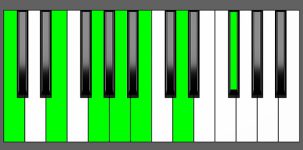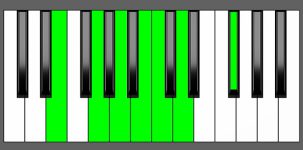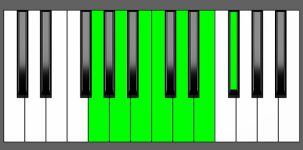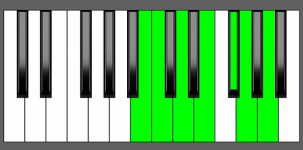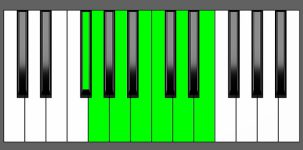Piano Diagram of Am13 in Root Position
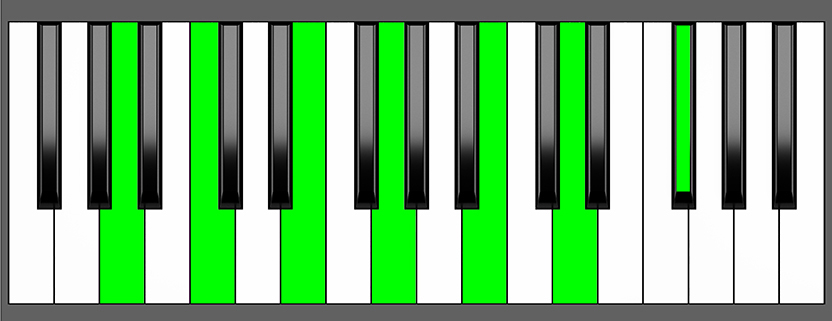
The Am13 chord is built upon the root note A and includes a minor 3rd (C), a perfect 5th (E), a minor 7th (G), a major 9th (B), an 11th (D), and a 13th (F#). This chord bears resemblance to a minor 6th chord due to the presence of the 13th, which is essentially a 6th note played at a higher octave. However, it also includes a minor 7th, major 9th, and 11th notes, which contribute to creating a sense of tension and dissonance.
Structure of Am13
Notes |
|---|
| A, C, E, G, B, D, F# |
Intervals |
|---|
| R, m3, 5, m7, 9, 11, 13 |
Playing Extended Chords on Piano
Extended chords like the Am13 can be challenging to play due to the large number of notes they involve. To simplify them, pianists often use different strategies like omitting certain notes or dividing the chord between both hands.
How to play an Am13
When playing an Am13 chord, you can play the root note A with the left hand and use the right hand to play the minor 7th note G, the 9th note B, and the 13th note F#. This way, you can play a simplified Am13 chord that includes only the root note, minor 7th, 9th, and 13th notes:
A + G, B, F#
Another option is to play the root note with the left hand and use the right hand to play an inversion of the chord with the 7th note (G), the minor 3rd note (C), and the 13th note (F#):
A + G, C, F#
Also, you could play an Am13 just playing the root note with the left hand and the 9th, the 3rd, and the 13th with your right hand:
A + B, C, F#
Despite using these techniques, extended chords can still produce dense and complex harmonies. When the chords are inverted, the resulting clusters of notes can be particularly challenging to play effectively and require careful voicing.
Am13 Chord Inversions
The Am13 chord has a total of 6 inversions:
| Root Position: | A | C | E | G | B | D | F# |
| 1st Inversion: | C | E | G | A | B | D | F# |
| 2nd Inversion: | E | G | A | B | C | D | F# |
| 3rd Inversion: | G | A | B | C | D | E | F# |
| 4th Inversion: | B | C | D | E | F# | G | A |
| 5th Inversion | D | E | F# | G | A | B | C |
| 6th Inversion | F# | G | A | B | C | D | E |
Piano Keyboard Diagrams
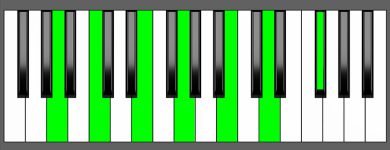
Am13 Chord – Root Position
- Am13 Chord – 1st Inversion
- Am13 Chord – 2nd Inversion
- Am13 Chord – 3rd Inversion
- Am13 Chord – 4th Inversion
- Am13 Chord – 5th Inversion
- Am13 Chord – 6th Inversion
Chord Inversion on Piano
Having a solid understanding of chord inversions is a crucial element of music theory since it sheds light on how chords are constructed. When it comes to playing chord inversions on a piano, it’s essential to keep in mind that the charts and graphs depicting the order of notes may not always be feasible or even playable.
To achieve the proper chord voicings on a piano, you must spread the chord notes across various octaves and positions on the keyboard. This often entails deviating from the typical shape of the chord’s inversions shown in charts, which may not be the most practical or comfortable way to play the chord.
While chord inversion charts can help understand the structure and sequence of notes in a chord, it’s always a good idea to experiment with different voicings and fingerings to find the most efficient and comfortable way to play the chord, while still preserving its intended harmonic function and sound.
Music Theory and Harmony of Am13
The Am13 chord is a diatonic extension of Am7. While it can be substituted for the Am7 chord in any position, it is commonly used in conjunction with it. Nonetheless, it’s worth noting that certain positions may not be as effective when substituting Am13 for Am7.
Building the Am13 Chord: Different Approaches
Starting from the A Major Scale
To build a minor 13th chord, you would typically combine the root note, minor 3rd, 5th, minor 7th, major 9th, 11th, and 13th from a minor scale. However, for educational purposes, it may be clearer to demonstrate its construction using a major scale, as it better illustrates the relationship between intervals and their qualities.
To build an Am13, you can start with the A Major scale:

A Major Scale

A Major scale – Keyless Notation
To create an Am13 chord, apply the formula R, m3, 5, m7, 9, 11, 13 in the following way:
- Begin with the Root note, A.
- Select the 3rd interval, C# then subtract a half-step to get the minor 3rd C.
- Add the 5th interval, E.
- Select the 7th interval, G#, and lower it down by a half-step to get the minor 7th, G.
- Add the major 9th, B.
- Pick the 11th D, which is a 4th interval at the higher octave.
- Lastly, add the 13th (F#) which is a 6th at a higher octave.
By following this simple formula, you can create a minor 13th chord from any major scale.
by Combining Intervals
One method to create a minor 13th chord is by combining specific intervals – a minor 3rd, a major 3rd, a minor 3rd, a major 3rd, a minor 3rd, and a major 3rd. This is the formula:
m3 + 3 + m3 + 3 + m3 + 3 = minor 13th Chords
Upon analysis of the Am13 chord, we can note that:
- the interval between A and C is a minor 3rd,
- between C and E is a major 3rd,
- between E and G is a minor 3rd,
- between G and B is a major 3rd,
- between B and D there is a minor 3rd,
- and finally, between D and F# there is a major 3rd.
by Combining Chords
Another way to build minor 13th chords is by combining a minor triad with a Maj 7th chord derived from its minor 7th, or by merging a minor 7th chord with a minor triad that is based on its second interval.
To build an Am13 chord, you can blend an A minor triad (A, C, E) with a G Maj7 chord (G, B, D, F#) or an Am7 (A, C, E, G) with a B minor (B, D, F#).
Am + G Maj7 = Am13
or
Am7 + B min = Am13
How to Use Am13 in a Chord Progression
The A minor 13th chord is a more complex version of the A minor 7th chord, as it includes additional notes such as the 9th, 11th, and 13th. These extra notes add a lot of dissonance and tension to the chord, which can make it tricky to use in a chord progression. Even if you leave out some of the notes, you still need to find the right voicing, because the effect of the Am13 depends on how it fits in with the other chords. It’s important to experiment with different voicings and figure out what works best with your particular progression.
In this post, we will focus just on the most common uses of the Am13 chord. The tables of the major and minor keys below include the A minor 7th chord, which can be substituted or complemented by an A minor 13th chord.
on Natural minor Scales
| Minor Scales | i | ii | III | iv | v | VI | VII |
|---|---|---|---|---|---|---|---|
| A | A min7 ⇒ Am13 | Bm7b5 | C Maj7 | D min7 | E min7 | F Maj7 | G7 |
| E | E min7 | F#m7b5 | G Maj7 | A min7 ⇒ Am13 | B min7 | C Maj7 | D7 |
| D | D min7 | Em7b5 | F Maj7 | G min7 | A min7 ⇒ Am13 | Bb Maj7 | C7 |
- Tonic chord in A minor
- Subdominant chord in E minor
- Non-diatonic Dominant chord in D minor
on Major Scales
| Major Scales | I | ii | iii | IV | V | vi | vii |
|---|---|---|---|---|---|---|---|
| G | G Maj7 | A min7 ⇒ Am13 | B min7 | C Maj7 | D7 | E min7 | F#m7b5 |
| F | F Maj7 | G min7 | A min7 ⇒ Am13 | Bb Maj7 | C7 | D min7 | Em7b5 |
| C | C Maj7 | D min7 | E min7 | F Maj7 | G7 | A min7 ⇒ Am13 | Bm7b5 |
- Supertonic chord in G Major
- Non-diatonic Mediant chord in F Major
- Submediant chord in C Major
Non-diatonic positions in D minor and F Major
It’s important to note that the major ninth interval B clashes with the Bb note found in both the D minor and F major scales, as they are only a half step apart. As a result, it’s generally recommended to avoid using the A minor 13th chord in these particular positions. However, rather than simply telling you to avoid it altogether, I believe the best approach is to test the dissonance of the Am13 chord in those positions and make a judgment call based on your own preferences.
Am13 Function in Major and Minor Keys
Understanding Scale Degrees
Understanding scale degrees is essential for comprehending the relationship between the notes within chords and how they function. The diatonic major scale consists of seven degrees, each with a distinct role in shaping the overall harmony of the chords.
- The first degree of the scale is the Tonic, serving as the foundation for the chord progression. It establishes a stable tonal center, providing an anchor for the rest of the chords in the progression.
- The second degree is called the Supertonic, often used to create a sense of motion within the chord progression. It acts as a transitional chord between the Tonic and other chords in the progression.
- The third degree of the scale is the Mediant, sitting halfway between the Tonic and Dominant chords. It helps determine whether the chord progression is major or minor.
- The fourth degree is the Subdominant, complementing the Dominant and adding tension and resolution to the chord progression.
- The fifth degree is the Dominant, creating tension and anticipation within the chord progression, typically resolved by returning to the Tonic.
- The sixth degree is the Submediant, often employed as a transitional chord between the Dominant and Tonic, adding a sense of stability and restfulness to the chord progression.
- The seventh degree is the Leading tone, located one half-step below the Tonic. It creates a strong sense of tension and a desire to resolve to the Tonic, frequently used to create a sense of resolution and finality in the chord progression.
Am13 as Tonic Chord in A minor
The A minor 13th chord is an interesting and distinct choice for the tonic chord in the A minor key.
| i | ii | III | iv | v | VI | VII |
| A min7 | Bm7b5 | C Maj7 | D min7 | E min7 | F Maj7 | G7 |
Am13 Chord Progressions as i degree
The following chord progressions are examples of how the A minor 13th chord can serve as the tonic chord (i degree).
i VI VII III
| i | VI | VII | III |
| Am13 | Am7 | F Maj7 | G7 | C Maj7 |
i iv VI VII
| i | iv | VI | VII |
| Am13 | Am7 | D min7 | F Maj7 | G7 |
I prefer resolving the A min13 chord to a more stable A chord (A minor or A minor 7th) within the same measure, but I encourage you to explore different options and experiment with other chord progressions to see what sounds best to you.
Circle Progression
| i | iv | VII | III | VI | ii | V7 | i |
| Am13 | Am7 | D min7 | G7 | C Maj7 | F Maj7 | Bm7b5 | E7 | A min7 |
Am13 as Subdominant Chord in E minor
The A minor 13th can also be played as the subdominant chord in the key of E natural minor.
| i | ii | III | iv | v | VI | VII |
| E min7 | F#m7b5 | G Maj7 | A min7 | B min7 | C Maj7 | D7 |
Am13 Chord Progressions as iv degree
The following chord progressions feature an Am13 chord as the subdominant (iv degree):
iv III VI VII
| iv | III | VI | VII |
| Am13 | Am7 | G Maj7 | C Maj7 | D7 |
i iv VI v
| i | iv | VI | v |
| E min7 | Am13 | Am7 | C Maj7 | B min7 |
Circle Progression
| i | iv | VII | III | VI | ii | V7 | i |
| E min7 | Am13 | Am7 | D7 | G Maj7 | C Maj7 | F#m7b5 | B7 | E min7 |
Am13 as Dominant Chord in D minor (Non-Diatonic)
The Am13 chord can also function as a variation of the dominant chord in the D minor key. Note that the 9th interval B may clash with the Bb note found in the D minor scale, as they are a half step apart.
| i | ii | III | iv | v | VI | VII |
| D min7 | Em7b5 | F Maj7 | G min7 | A min7 | Bb Maj7 | C7 |
Am13 as v degree – Chord Progressions
To hear how the A minor 13th chord sounds as the dominant (V) chord in the D minor key, you can try playing the following chord progressions:
i iv VI v
| i | iv | VI | v |
| D min7 | G min7 | Bb Maj7 | Am13 | Am7 |
i v VI VII
| i | v | VI | VII |
| D min7 | Am13 | Am7 | Bb Maj7 | C7 |
i VI v iv
| i | VI | v | iv |
| D min7 | Bb Maj7 | Am13 | Am7 | G min7 |
Am13 as Supertonic Chord in G Major
Besides its use in minor keys, the Am13 chord can also be played in major keys. In the key of G major, for instance, the Am13 chord can be used as the supertonic chord, located on the second degree of the scale.
| I | ii | iii | IV | V | vi | vii |
| G Maj7 | A min7 | B min7 | C Maj7 | D7 | E min7 | F#m7b5 |
Am13 Chord Progressions as ii degree
Try playing the following chord progressions to better understand how the Am13 chord functions as the supertonic (ii) chord in the key of G major.
ii V I
| ii | V | I |
| Am13 | Am7 | D7 | G Maj7 |
Circle Progression
| I | IV | vii | iii | vi | ii | V | I |
| G Maj7 | C Maj7 | F#m7b5 | B min7 | E min7 | Am13 | Am7 | D7 | G Maj7 |
Am13 as Mediant Chord in F Major (Non-Diatonic)
In addition to its positions in minor keys and major keys, the Am13 chord can also be played as the mediant (iii) chord in the key of F major, located on the third degree of the scale.
The 9th note (B) of Am13 will eventually clash against the Bb present in the F major scale so be aware of the issue you could encounter using a non-diatonic chord.
| I | ii | iii | IV | V | vi | vii |
| F Maj7 | G min7 | A min7 | Bb Maj7 | C7 | D min7 | Em7b5 |
Am13 Chord Progressions as iii degree
To better understand how the Am13 serves as the mediant (iii) in the F major scale, you can try playing the following chord progressions.
I iii IV V
| I | iii | IV | V |
| F Maj7 | Am13 | Am7 | Bb Maj7 | C7 |
I iii ii V
| I | iii | ii | V |
| F Maj7 | Am13 | Am7 | G min7 | C7 |
I iii vi V
| I | iii | vi | IV |
| F Maj7 | Am13 | Am7 | D min7 | Bb Maj7 |
Am13 as Submediant Chord in C Major
The Am13 chord can be played on the sixth degree of the C major scale, as a variation of the submediant chord.
| I | ii | iii | IV | V | vi | vii |
| C Maj7 | D min7 | E min7 | F Maj7 | G7 | A min7 | Bm7b5 |
Am13 as vi degree – Chord Progressions
You can explore the sound of Am13 as the submediant chord in the key of C major by playing the following chord progressions:
I iii vi V
| I | iii | vi | V |
| C Maj7 | E min7 | Am13 | Am7 | G7 |
I vi ii V
| I | vi | ii | V |
| C Maj7 | Am13 | Am7 | D min7 | G7 |
Circle Progression
| I | IV | vii | iii | vi | ii | V | I |
| C Maj7 | F Maj7 | Bm7b5 | E min7 | Am13 | Am7 | D min7 | G7 | C Maj7 |
Alternative Am13 Nomenclature
- A m13
- A m13th
- A m11/13
- A min13th
- A minor 13
- A m7/9/11/13
- A minor thirteenth
Conclusion
The chord progressions and examples in this post give a comprehensive overview of the common uses of the Am13 chord. However, it’s important to note that many advanced topics in harmony couldn’t be included due to space limitations. These topics include chord progressions based on different scales, modal scales, hidden tonality, secondary dominants, chord substitutions, non-functional harmony, atonal music, modal interchange, borrowed chords, voice leading, counterpoint, chromatisms, jazz harmony…I mean, music theory is a huge topic!
Although I couldn’t cover all of these topics in my post, I encourage readers to continue exploring these areas in their own study and research. By expanding your knowledge in these advanced areas of music theory, you can gain a deeper understanding of the harmonic possibilities that exist beyond the basics presented here.
